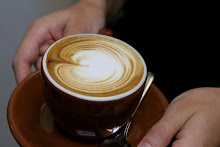Recently I was given an opportunity to attend (test) for Q grader certification with Jamin Haddox at Cafe Imports in Saint Paul. Cafe Imports has an outstanding Quality Control and Cupping program maintained by the collective passion of the sales staff, all of whom cup and help make decisions.
Here in South Saint Paul the Coffee we choose has much to do with the customers that come in through the door. By and large the first request is for a 'roast' I'll try the Brazil Roast or the 'light roast' thinking that it will be light in body, or perhaps more accurately mild.
Many of the assumptions first time customers to our cafe have are the result of the marketing campaigns of larger outfits such as Caribou, Starbucks, and Dunn Brothers. Customers sometimes have different ideas of terms and definitions, so let me elucidate a few we use:
Origin: The country of Origin- This is important because for the most part, coffee from Brazil will never taste like coffee from Kenya. Coffee from Ethiopia is a different beverage than coffee from Yemen.
Roast: This is the process of heating the coffee to a certain temperature in a certain way- called a roast profile. Generally speaking Roasts last between 11-14 minutes here at Black Sheep. We use a coffee roaster with Good Convective and Conductive heat balance.
 |
| Evaluating sample roasts. |
Micro Lot: This term is somewhat new, and is used solely to connect a certain coffee to the people that are responsible for it. Sometimes the local Mill. Sometimes one farmer, one family, one collective of families. Micro Lots are anywhere from a few pounds to 20 bags (at our current scale of production.)
Light/Dark: People often assume that a certain roast has more caffeine or less- when actually caffeine is not really affected by the roasting process. Light roast tends to brew differently and can result in a higher caffeine content per ounce- but this depends more on the brew method than the roast. Two coffees brewed under the same time, temperature, and dosages would extract differently because of the roast- it's complicated. Just know that strong dark roast could potentially have more caffeine than thin light roast- even though both may be tasty and well-crafted beverages.
Brew Method: Coffee is the seed of a cherry, roasted and caramelized, essentially, so it must be converted into a liquor (beverage) for consumption. There are many different ways to grind, steep, extract, and filter coffee that change it's composition and flavor profile in your cup. All of these are most easily related to the process of CUPPING which is the universal way to taste and evaluate coffee.
Cupping: For our purposes, we use the standards set forth in the Specialty Coffee Association of America's Cupping protocols. There are strict standards for water quality, water temperature, coffee dosage, degree of roast, timing, etc. An attempt is made to make the tasting process as precise and controlled as possible so as to be 'Honest' with all coffee. For example, water must be between 125 and 175 ppm or 'parts per million' which is a measure of dissolved solids, (mineral content). We dose our coffee at 8.25 grams per 150 ml of water, etc. etc.
The coffee is ground, and a DRY AROMA is evaluated.
Water is boiled- allowed to cool to between 195-205 degrees F, then poured over each ground cup.
Cups are allowed to steep for at least 3:00 and no more than 5:00.
The CRUST is broken with a spoon and the WET AROMA is evaluated.
The Coffee liquor is allowed to cool to at least 165 degrees or below- then tasted via Slurping.
We SLURP because most (75%) of taste has to do with fragrance- simply drinking is not as intense or meaningful experience as smelling and tasting at the same time.
As the coffee cools further, we continue to evaluate the taste to see how it changes over time. We evaluate Sweetness, Acidity, Aftertaste, Body (the mouthfeel of a coffee), Balance, Cleanliness, and other traits such as whether this coffee conforms to origin expectations, or whether it displays cleanliness and consistency.
More soon.
Pete

No comments:
Post a Comment